How to use Biocheck.UGent
Here is an overview on how to use our Biocheck.UGent platform:
Tutorial
Is it the first time you're using Biocheck.UGent? Want to know more how it works? At Biocheck.UGent we have developed a short tutorial on how to use the different parts of the website. You can follow the tutorial by clicking here.
Alternatively, you can watch our tutorial video to learn how to use the Biocheck.UGent platform and get started quickly and easily. Check it out here.

Language
Choose your language in the top navigation menu.
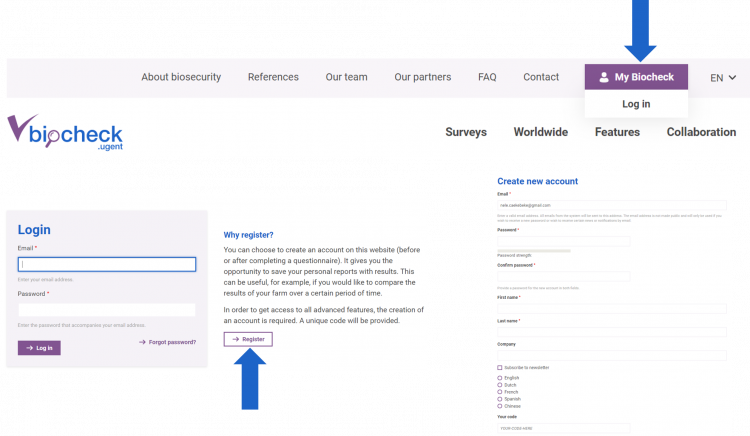
Registration
New users can register by going to the My Biocheck tab and then Log in.
This is not obligatory, however highly recommended as this creates an account where you can save all your reports online.
If you have an access code for advanced features, this can be entered at the end.
You will receive an email confirmation.

Your dashboard
Your submissions are accessible through the My Biocheck button.
All your saved or shared (advanced access) reports are stored on the dashboard.
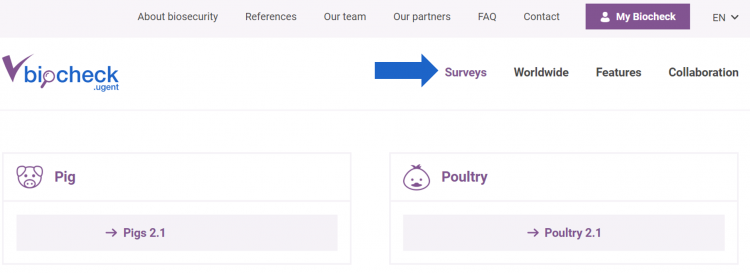
Survey
All surveys can be found in the corresponding tab of the main menu or on the homepage at "Start the Biocheck.UGent".
After selecting the survey of your choice, you can download an offline printable version (.pdf) of the survey or fill it in online.
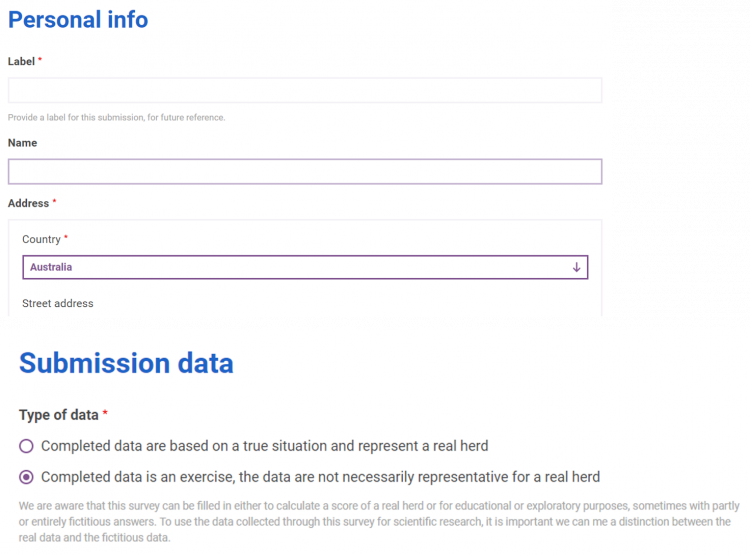
All questions with an "*" are obligatory.
After completion of the entire survey, you will be asked whether your data is real or an exercise. Please answer carefully! The real data will be included in our worldwide database.

Report
You can save the report to your account or generate it only once.
Saved reports will be added to your My Biocheck tab in .pdf format.
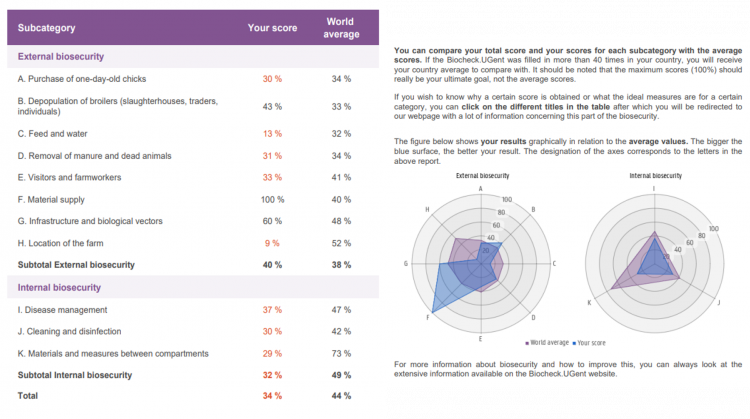
The basic report will include a table with your results, a world average and a country average if there are more than 40 entries for your country.
The higher your score, the better!
Scores will be highlighted in red when they are below the average (below the country average, or below the world average whenever there is no country average).
Your scores are also visualised in spider plots. The blue area is your score, the purple is the world average. The bigger the area, the better.

Personalised feedback
Advanced users have access to an advanced report (in .docx format). Here personalised feedback is given based on the answers given in the survey.
You have the possibility to add information and/or logo's of your own.
The 5 principles of biosecurity
When designing biosecurity programs, there are some general principles that are of value in all settings.
- 1. Separation of high and low risk animals and environments
To avoid disease transmission it is important to try to keep the sources of infection (e.g. animals, persons, vermin) separated from the susceptible contacts as much as possible. This can be achieved through the prevention of direct contacts between high risk (infectious) and low risk (susceptible) animals as well as the prevention of indirect contacts. - 2. Reduction of the general infection pressure
Even with the best possible biosecurity measures, it is not possible, and probably not even desirable, to keep animals under sterile conditions. Therefore, it is very hard to prevent every contact with potential harmful infectious agents, yet biosecurity measures aim at reducing the infection pressure under a level which allows the natural immunity of the animals to cope with the infections. - 3. Not every transmission route is equally important
Some transmission routes may transmit many different pathogens with a high efficiency (e.g. direct animal contact), whereas other transmission routes (e.g. feed) are of less importance. Therefore, when designing biosecurity control programs, it is of importance to focus first on the high risk transmission routes and only subsequently on the lower risk transmission routes. - 4. Risk is a combination of probability of transmission and frequency of occurrence of transmission routes
Besides the probability of transmission of a pathogen through the different transmission routes, also the frequency of occurrence of the transmission route plays a very significant importance. If a certain transmission route (eg. transmission via hand of animal care takers) has only a low probability of occurrence but it is repeated very frequently (eg. animal care taker is touching the animals several times a day without precautionary measures), the risk of disease transmission ends up being very substantially anyway. - 5. Larger animal groups pose higher risks
The larger herds or flocks are becoming, the more important biosecurity measures will be. In large groups of animals there are more animals that can become infected and maintain an infection cycle to subsequently build up the infection pressure above the limit that the animals can cope with. Moreover, larger herds or flocks have more frequent contacts with the outside world (eg. movements of animals, transport of feed, professional visitors, among others) that all may carry a certain risk of disease introduction. Also in larger and high productive herds, the high-producing animals may be more susceptible and therefore the consequences of disease introduction may be more severe compared to smaller herds.
Reference: Dewulf J., Postma M., Van Immerseel, F., Vanbeselaere, B., Luyckx, K., 2018. How to measure biosecurity and the hygiene status of farm? Biosecurity in Animal production and Veterinary Medicine, Chapter 5, Editors Dewulf J. and Van Immerseel F. (available on Amazon, Cabi and Acco)
How our surveys are built
The Biocheck.UGent system is a risk-based scoring system to quantify the on-farm biosecurity (Laanen et al., 2010; Gelaude et al., 2014; Ghent University, 2015). It does not start from a specific disease but rather approaches biosecurity in general and focusses on those aspects that are common for the transmission of many different types of infectious diseases. The surveys are divided into several subcategories for internal and external biosecurity, and every subcategory consists of 2 to 19 questions. Most questions have two or three answer options. The answer to every question results in a score between zero (when this measure is not implemented at all or the least optimal answer is given) and one (when the measure is fully implemented). Depending on the importance of a particular biosecurity measure, the score per question is multiplied by a weight factor (Laanen et al., 2013; Gelaude et al., 2014). The weights per score are determined based upon the 5 principles of biosecurity.
Also the subcategories have a specific weight factor equal to their relative importance for disease transmission as determined by a large group of specialist (Laanen et al., 2013; Gelaude et al., 2014). As such, the Biocheck.UGent scoring system provides a risk-based score which takes into account the relative importance of all different biosecurity measures. The final score for both internal and external biosecurity can range from zero, indicating a total absence of the described biosecurity measures, to 100, indicating a full application of the described measures. The average of internal and external biosecurity results in a score for the total biosecurity.
Reference: Dewulf J., Postma M., Van Immerseel, F., Vanbeselaere, B., Luyckx, K., 2018. How to measure biosecurity and the hygiene status of farm? Biosecurity in Animal production and Veterinary Medicine, Chapter 5, Editors Dewulf J. and Van Immerseel F. (available on Amazon, Cabi and Acco)
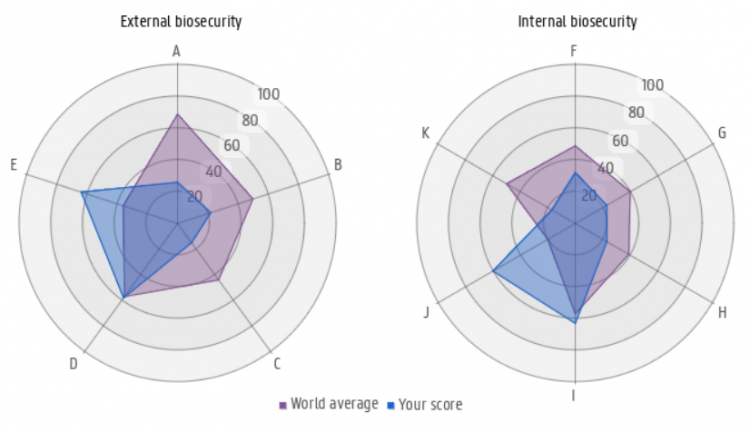
Basic report
For each subcategory of the survey, you get your own score, a worldwide (global) average and if available a national average. The average of all scores per subcategory within external and internal biosecurity, after taking their specific weight into account, gives a subtotal for external and internal biosecurity. The average of internal and external biosecurity results in a score for the total biosecurity.
Spider plots
The letters in the different axis, correspond to the different subcategories within the survey. These letters are also in front of each subcategory in the table of the same report.
E. g. “A” is corresponding to the subcategory “purchase of animals and semen” in the pig survey.
If you wish to know which questions were responsible for this score, you can easily look it up again in the paper/online version of the survey. For subcategory A this is corresponding to question 1 to 16 in the pig survey.
Weight factors
More information on the different weight factors per animal species can be found below. Each subcategory within external and internal biosecurity has its own weight.
Scientific publications using Biocheck.UGent
The Biocheck.UGent was already numerous times used in academic research. A non-limitative list is found here. Want more information? Click here!
- Impact of biosecurity on production performance and antimicrobial usage in broiler farms in Cameroon (Ziebe et al., 2025)
- Development and use of Biocheck.UGent scoring system to quantify biosecurity in conventional indoor (turkey, duck, breeder) and free-range (layer and broiler) poultry farms (Amalraj et al., 2024)
- Factors Affecting Poultry Producers’ Attitudes towards Biosecurity (Amalraj et al., 2024)
- Assessment of Cleaning and Disinfection Practices on Pig Farms across Ten European Countries (Makovska et al., 2024)
- Biosecurity and antimicrobial use in broiler farms across nine European countries: toward identifying farm-specific options for reducing antimicrobial usage (Mallioris et al., 2023)
- Situation Analysis and Recommendations for the Biosecurity Status of Dairy Farms in Punjab, India: A Cross-Sectional Survey (Dhaka et al., 2023)
- Viral metagenome-based precision surveillance of pig population at large scale reveals viromic signatures of sample types and influence of farming management on pig virome (He et al., 2021)
- Coaching Belgian and Dutch broiler farmers aimed at antimicrobial stewardship and disease prevention (Caekebeke et al., 2021)
- Antimicrobial use, biosecurity, herd characteristics, and antimicrobial resistance in indicator Escherichia coli in ten Finnish pig farms (Yun et al., 2021)
- Biosecurity levels of pig fattening farms from four EU countries and links with the farm characteristics (Chantziaras et al., 2020)
- Herd typologies based on multivariate analysis of biosecurity, productivity, antimicrobial and vaccine use data from Danish sow herds (Kruse et al., 2020)
- Biosecurity assessment of layer farms in Central Luzon, Philippines (Tanquilut et al., 2020)
- Biosecurity Level Practices in Pig and Poultry Production in Vietnam (Thi Kim Cuc et al., 2020)
- A risk-based scoring system to quantify biosecurity in cattle production (Damiaans et al., 2020)
- Quantitative assessment of biosecurity in broiler farms using Biocheck.UGent in Central Luzon, Philippines (Tanquilut et al., 2020)
- Using the Biocheck.UGent™ scoring tool in Irish farrow-to-finish pig farms: assessing biosecurity and its relation to productive performance (da Costa et al., 2019)
- Scoring biosecurity in European conventional broiler production (Van Limbergen et al., 2018)
- Association Between Antimicrobial Usage, Biosecurity Measures as Well as Farm Performance in German Farrow-To-Finish Farms (Raasch et al., 2018)
- Review of transmission routes of 24 infectious diseases preventable by biosecurity measures and comparison of the implementation of these measures in pig herds in six European countries (Filippitzi et al., 2017)
- Evaluation of the relationship between the biosecurity status, production parameters, herd characteristics and antimicrobial usage in farrow-to-finish pig production in four EU countries (Postma et al., 2016)
- Farm-economic analysis of reducing antimicrobial use whilst adopting improved management strategies on farrow-to-finish pig farms (Rojo-Gimeno et al., 2016)
- Reducing antimicrobial usage in pig production without jeopardizing production parameters (Postma et al., 2017)
- Biocheck.UGent: A quantitative tool to measure biosecurity at broiler farms and the relationship with technical performances and antimicrobial use (Gelaude et al., 2014)